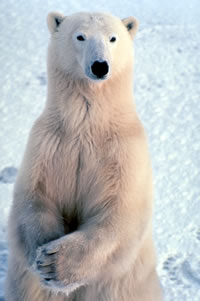Facts about polar bears
by Marie Gilbert, Institute of Arctic Biology

Names
- Scientific name: Ursus maritimus. The polar bear is also called nanook, nanuq, nanuk, ice bear, sea bear, eisbär, isbjørn and white bear. Nanook--a derivation of the Inupiaq Eskimo word “nanuq”--is the name for the polar bear mascot of the University of Alaska Fairbanks.
- Polar bears are considered marine mammals because their primary habitat is sea ice and not the adjacent land.
Distribution
(see graphics showing winter and summer distribution of sea ice and polar bears)
- Polar bears are found only in the Northern Hemisphere.
- Polar bears are common in the Chukchi and Beaufort seas north of Alaska; Baffin Bay, which separates Canada and Greenland, and most of the Canadian Arctic Archipelago.
- Polar bears are found throughout the East Siberian, Laptev and Kara seas of Russia and the Barents Sea of northern Europe.
Size, weight, fur
- Male polar bears, called boars, range between 1,100 and 1,300 pounds (500-600 kilograms).
- Females, called sows, weigh around 650 pounds (300 kilograms), unless they are pregnant and then they can weigh as much as a male.
- The heaviest bear weighed in Alaska (Amstrup) was 1,344 pounds (610 kilograms).
- Only prehistoric polar bears and the giant short-faced bear of the Pleistocene were larger than today’s polar bear.
- Except for the tip of their nose, polar bears are completely covered in fur. Even the pads of their feet are furred.
- Polar bear skin is uniformly black. Polar bear fur appears white, but actually does not contain pigment.
Myth of the polar bears’ optic-fiber-like hair
A popular arctic legend has it that polar bear hair acts as an optical fiber for ultraviolet light--funneling energy in the UV spectrum to the skin where it warms the bear’s body. The myth has persisted for more than two decades despite research by Daniel Koon, an associate professor of physics at St. Lawrence University in New York, showing polar bear hair does not behave like a fiber optic, either in the ultraviolet or in the visible spectrum. Koon’s research showed that less than a thousandth of a percent of ultraviolet light entering one end of a polar bear’s hair could travel one fifth the distance of a typical one-inch length of hair.
For more information visit:
- Polar Bears International
- The Myth of the Fiber-Optic Polar Bear by Daniel Koon
- Power of the polar myth by Daniel Koon
- Is Polar Bear Hair Fiber Optic? by Daniel Koon
Polar bear © Corel Corp.


